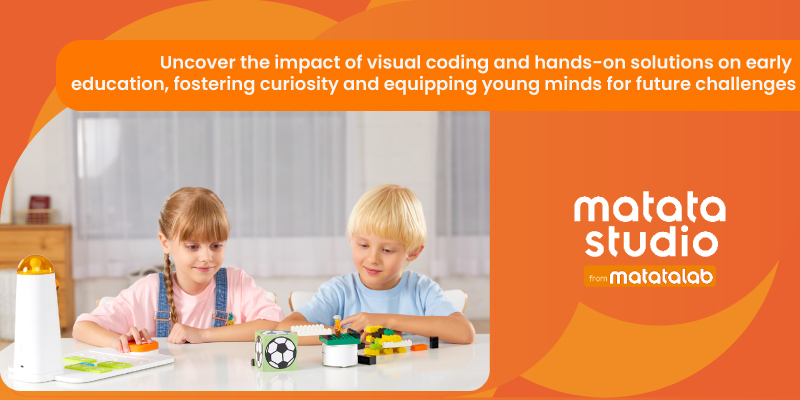Early learners, as young as 4 years old, can now embark on their STEAM journey with playful coding activities right in the classroom. Gone are the days when complex text-based programming was confined to higher education. Today, schools – like those in Dubai and other forward-thinking regions – are introducing the fundamentals of coding even in preschool, making it accessible to all ages. Age-appropriate solutions like hands-on coding and visual coding activities are replacing traditional text-based approaches, bridging the gap and making coding fun and easy for young minds. Through this Blog, we’ll explore the differences between visual coding for kids and hands-on coding for youngsters.
Visual Coding Solutions:
Visual coding for kids utilizes a graphical interface instead of text-based commands. Programs are created by dragging and dropping pre-defined blocks that lead to specific actions or functions. This approach allows children to focus on the logic and problem-solving aspects of coding without getting bogged down by syntax and complex commands. Visual coding uses drag-and-drop blocks on a computer (PC, laptop, tablet) to build programs, with software like Scratch or Blockly.
Benefits of Visual Coding for Kids
- Reduced Cognitive Load: Visual coding is easy to start with and doesn’t startle the learner with too much jargon. It is easier for young learners to grasp core coding concepts like sequences, loops, and variables by simply moving blocks around on the screen and using arrow keys.
- Enhanced Engagement: The drag-and-drop interface with animated characters and an appealing storyline provide a fun and interactive learning experience, keeping children motivated and engaged.
- Building Blocks for Textual Coding: Visual coding for kids is a stepping stone, introducing basic programming concepts that can be later translated into text-based coding languages.
MatataCode Visual Programming Solution:
MatataCode provides a visual programming solution ideal for children aged 8 and above. The platform utilizes VinciBot, a programmable robot, and MatataCode, a dedicated programming environment.
MatataCode Features
- User-Friendly Interface: With MatataCode, coding becomes a breeze! It features a drag-and-drop interface where colorful blocks represent different actions, like making a robot move, playing sounds, or responding to sensors.
- Interactive Learning: Children learn programming fundamentals while controlling the VinciBot, a programmable robot used with MatataCode. This enforces a tangible connection between their code and its real-world application.
- Scalability: As children become more proficient, they can explore more complex projects, making MatataCode a versatile tool for continuous learning.
Hands-on Coding Solutions:
Hands-on coding solutions emphasize a more physical approach, utilizing tangible objects and robots to introduce programming concepts. These solutions are ideal for younger children (ages 3 and above) who are still developing their fine motor skills and cognitive abilities.
Benefits of Hands-on Coding
- Tangible Learning Experience: By interacting with physical objects & robots, children can develop a deeper understanding of programming principles more concretely.
- Creative Exploration: Hands-on coding fosters creativity and problem-solving skills as children experiment with different coding sequences to achieve desired outcomes.
- Computational Thinking: These solutions introduce basic computational thinking skills like sequencing, logic, and decomposition at a young age.
MatataCode Hands-on Coding Solutions:
MatataCode offers two hands-on coding solutions catering to different age groups:
- Interactive Robot: Tale-Bot Pro allows young children to create stories and control movement using colorful coding blocks.
- Voice Feedback: The robot provides voice feedback, promoting language development and storytelling skills.
- Developmentally Appropriate: The tactile and visual elements are designed to engage younger children and support their developmental milestones.
Coding Set & Add-Ons (Ages 5+)
- Screenless Solution: This gamified solution features coding blocks that control a robot car, eliminating screen time and focusing on physical interaction.
- Problem-Solving Challenges: Children build sequences and solve challenges, fostering problem-solving and computational thinking skills.
- Modular Design: The set can be expanded with add-ons, allowing for more complex projects and extended learning opportunities.
Choosing the Right Solution
Both visual coding for kids and hands-on coding solutions provide valuable pathways for introducing children to the world of programming. However, the best solution depends on the individual child’s age, learning style, and interests.
Introducing coding to young children through visual and hands-on coding solutions can spark an early interest in STEM fields and develop essential problem-solving skills. Visual coding for kids provides a structured, engaging way to learn programming fundamentals, making it suitable for older children ready for a more formal coding education. In contrast, hands-on coding offers a playful, tactile approach that is perfect for younger children, fostering creativity and computational thinking from an early age. By selecting the appropriate solution based on the child’s age, learning style, and interests, parents and educators can effectively nurture the next generation of innovators and thinkers.

